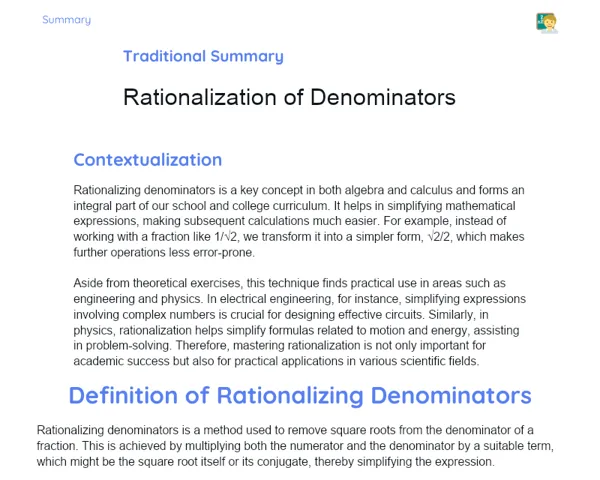Objectives
1. 🔍 Explore Area and Perimeter Measures: Understand how to accurately calculate and compare the areas and perimeters of geometric figures like squares, rectangles, and triangles.
2. 🛠️ Apply Concepts Practically: Use these measures in real-life situations and scenarios to address problems and make informed decisions.
3. 🤔 Develop Critical Thinking: Examine and compare figures with varying areas and perimeters, grasping their practical implications and uses.
Contextualization
Did you know that being able to calculate areas and perimeters is crucial in various professions and even in our everyday tasks? Architects use these principles to design homes and commercial buildings, farmers plan their fields, and decorators estimate materials to dress up interiors. These skills transcend mere mathematics; they have real-world applications that are incredibly useful!
Important Topics
Area of Geometric Figures
The area refers to the size of a two-dimensional surface—essentially the space contained within a rectangle, triangle, or square. To find the area, we multiply the length by the width (or height, depending on the figure). For example, a rectangle with lengths of 4 units and 6 units would have an area of 24 square units.
-
Formulas: The formulas for calculating area differ based on the figure. For instance, the area of a square is side * side, while that of a triangle is 0.5 * base * height.
-
Units of Measurement: Areas are typically expressed in square meters (m²) or square centimeters (cm²), depending on the scale.
-
Practical Applications: Knowledge of area is key for tasks like estimating paint for walls or figuring out the space needed for flooring.
Perimeter of Geometric Figures
The perimeter denotes the total distance around a figure, calculated by adding up all the sides. For example, the perimeter of a rectangle with sides measuring 4 units and 6 units is 20 units. Knowing how to calculate perimeter is essential for tasks like planning boundaries, walkways, or any task involving measurements around a shape.
-
Formulas: The formulas for perimeter are straightforward additions of the sides, such as for a square, where it is 4 times the length of one side.
-
Units of Measurement: Perimeter is measured in the same units as the sides, like meters or centimeters.
-
Practical Applications: This knowledge is important in garden design, road construction, and various engineering and design projects.
Comparison of Areas and Perimeters
It's vital to understand that figures can have the same perimeter but different areas, and vice versa. This arises from the various combinations of side lengths in shapes that keep the same perimeter but differ in area. For instance, a rectangle with sides 2 and 8 has the same perimeter as a square with side 5, yet their areas differ.
-
Logical Reasoning: Sharpen logical reasoning skills by exploring how adjusting a figure's dimensions influences its area and perimeter.
-
Applications in Engineering: This is crucial in optimizing materials, like selecting shapes that maximize surface area with minimal resources.
-
Mathematical Challenges: Comparing figures with equal areas but different perimeters (or the other way around) presents exciting mathematical puzzles.
Key Terms
-
Area: The measure of a two-dimensional space within a figure.
-
Perimeter: The total distance around the edges of a figure.
-
Units of Measurement: Standard ways to express dimensions, such as square meters (m²) and centimeters (cm).
-
Formulas: Mathematical expressions used to determine area and perimeter for various geometric figures.
For Reflection
-
In what ways does changing a figure's dimensions influence its area and perimeter? Share real or hypothetical examples.
-
Why is distinguishing between area and perimeter significant in practical scenarios like design and construction?
-
How can a sound understanding of areas and perimeters help tackle everyday challenges?
Important Conclusions
-
Today, we explored the intriguing concepts of area and perimeter within geometric figures, learning how to compute and compare these measures in various situations.
-
We found that shapes sharing the same perimeter can exhibit quite different areas, a vital insight for many real-world applications such as park planning and efficient space usage.
-
We highlighted that these concepts serve not only as mathematical tools but also as critical skills applicable in numerous professional environments and daily life.
To Exercise Knowledge
- Design Your Dream Park: On graph paper, sketch a blueprint for a park featuring a lake, a playground, and winding paths. Calculate the total area of your park along with each element. 2. Equal Perimeter Challenge: Create three diverse figures that maintain the same perimeter yet differ in their areas. Compute and compare their areas. 3. Planning with Perimeter: Imagine you have a fixed-length piece of cloth. Draw different shapes that this fabric could take, assessing the area each shape would cover.
Challenge
🌟 Junior Architect Challenge: You’re tasked with being the architect for a new city park! Using a given fixed perimeter, draft a park layout that optimizes the area of each feature (such as the lake, playground, and gardens), ensuring both aesthetic appeal and functionality. Present your design complete with calculations and reasoning behind your choices.
Study Tips
-
Utilize sketches and real models to practice area and perimeter calculations, enhancing visual understanding.
-
Create study cards featuring formulas and examples for calculating area and perimeter for regular revision.
-
Engage conversations with peers or family about the relevance of areas and perimeters in everyday contexts like home decoration or landscaping to observe mathematics in daily scenarios.



